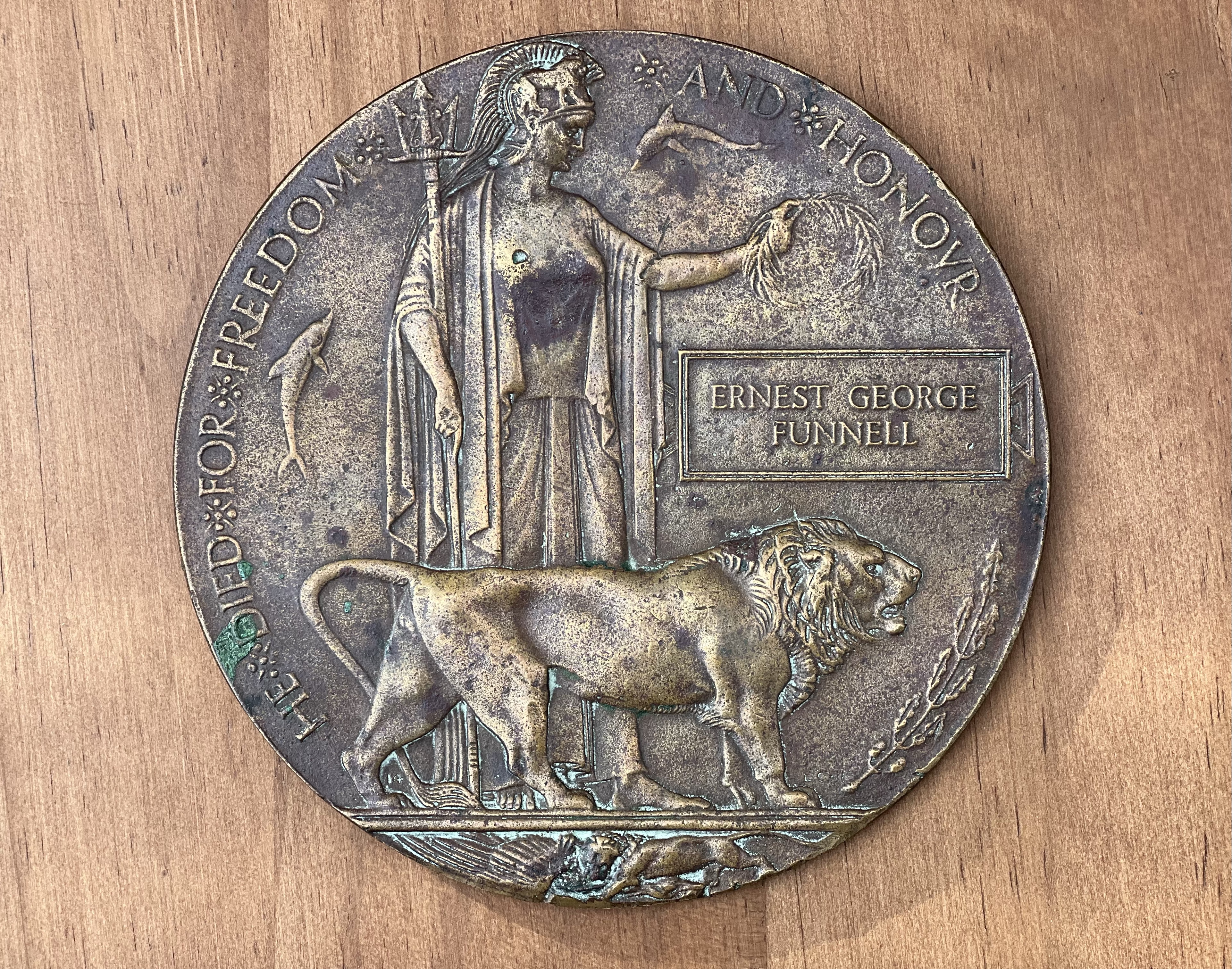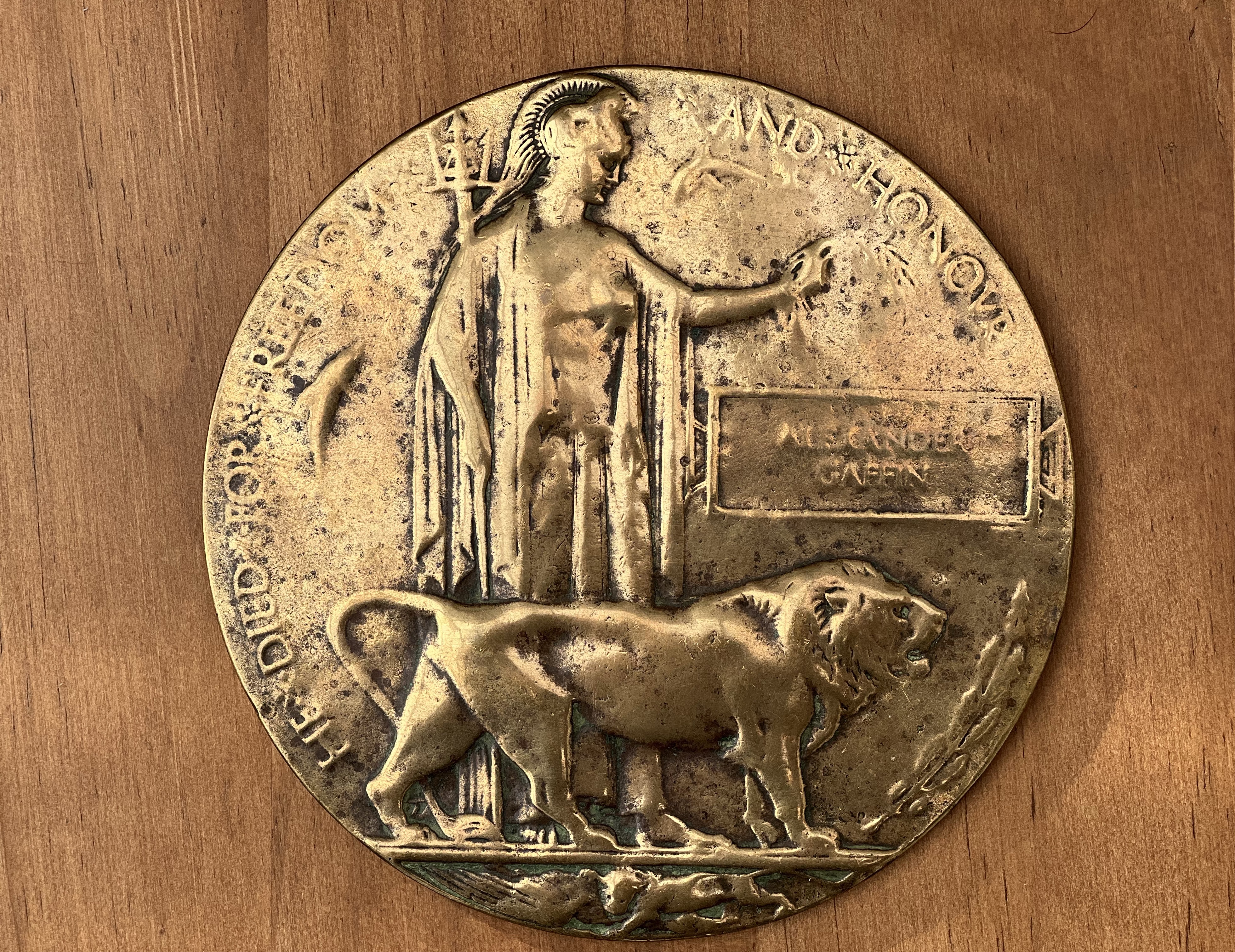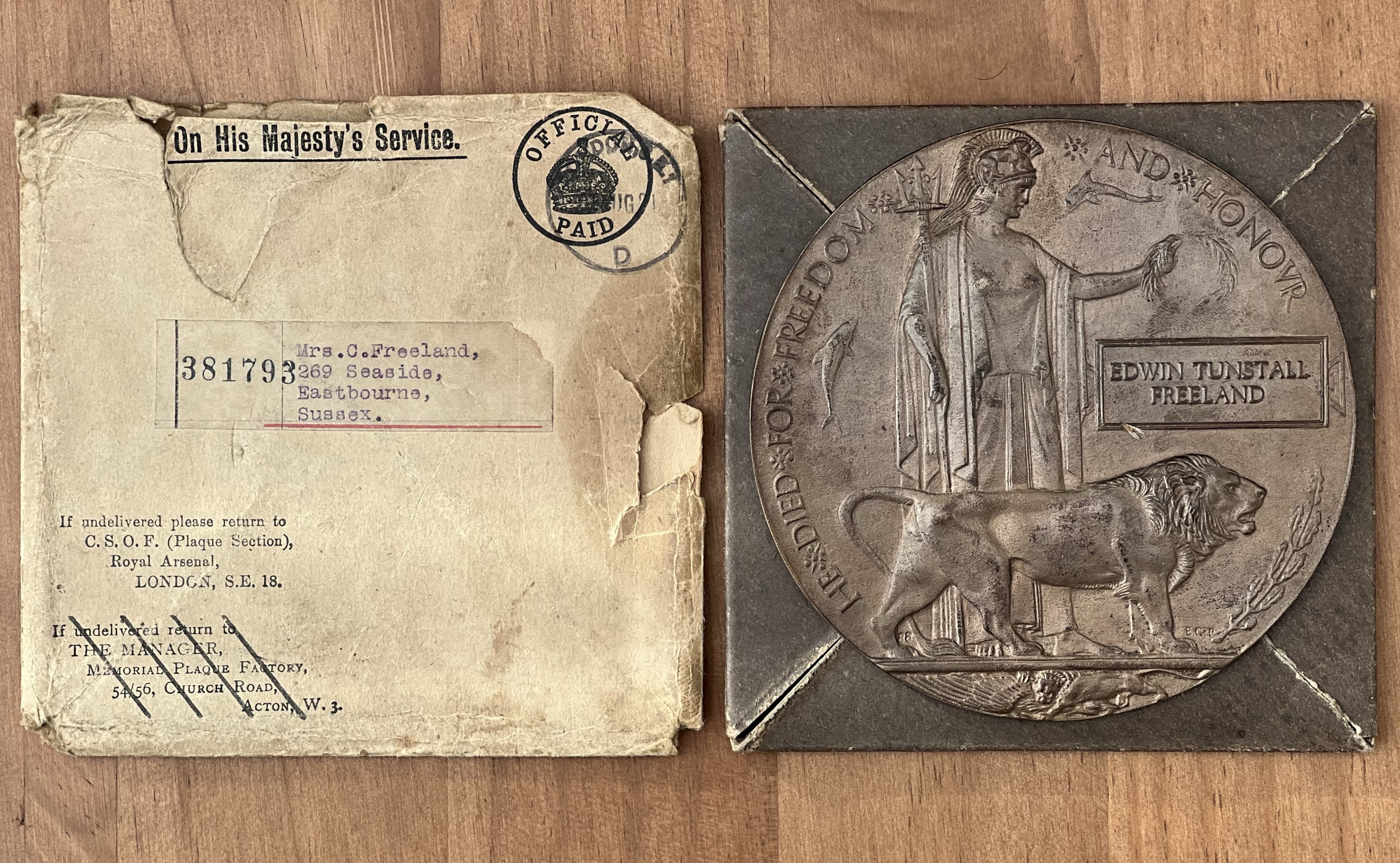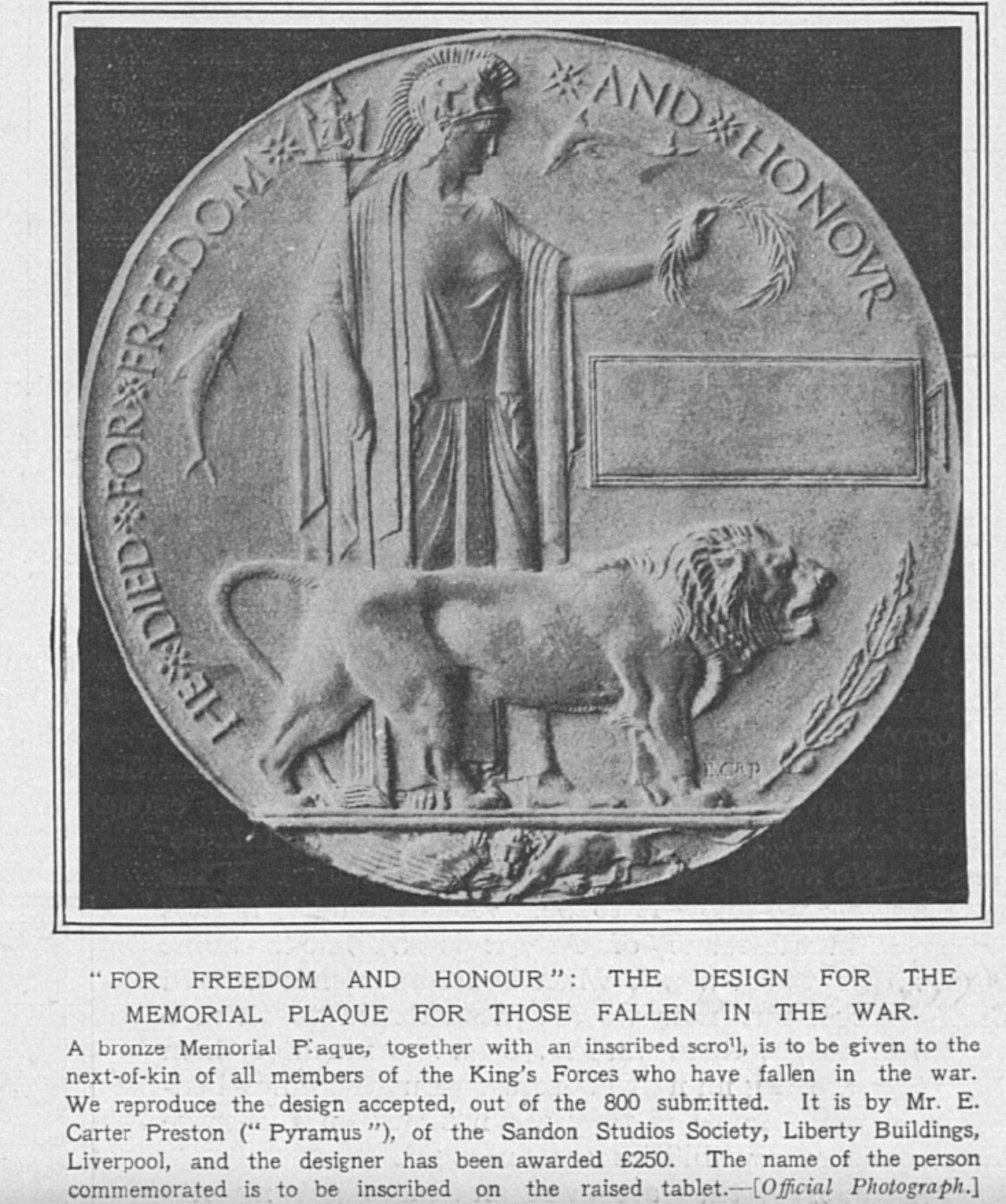Old Front Line
WW1 Podcast with Paul Reed
The Dead Man’s Penny

While the Great War was still on the British Government decided to produce a Next of Kin Memorial Plaque for all those who had died while on service in the conflict, which read ‘He Died For Freedom and Honour’. Often called a “Dead Man’s Penny” or ‘Widow’s Penny” or even ‘Death Plaque”, eventually over 1.1 million were produced for every British and Commonwealth service men and women who died. In this episode of Despatches, we examine their history and what these objects mean more than a century later.
USEFUL LINKS:
Bronze Memorial Plaques: Notes on origins, history, and identification.
The Great War website: WW1 Memorial Plaques.
Imperial War Museum: Next of Kin Memorial Plaque.
Australian War Memorial: WW1 Memorial Plaques.
Australian Memorial Plaques: Plaques to the AIF.
Canadian War Memorial: Canadian WW1 Memorial Plaques.
Podcast Extras:








Thank you Paul for the beautiful ly told history of the Memorial Plaques. Superb Despatch!
LikeLiked by 1 person
Thank you, Bill!
LikeLike
Hi Paul
I have just become the proud custodian of a WW1 Memorial Plaque and found your Podcast absolutely superb.
One question, from my research. You say that Woolwich Arsenal took over production from Dec 1920 but on the Great War Forum – Memorial Plaque Production section
Sullivan Old Sweats 6 Nov 2002 states he has a Woolwich produced Plaque for Huxtable that was sent to the family in Jun 1919????
LikeLiked by 1 person
Great listen, the stories and memories of each plaque have always fascinated me, thank you.
LikeLike
Paul…I couldn’t agree with you more…the link between these plaques and the men they commemorate is so powerful, so incredibly moving…
LikeLike
I found this episode particularly poignant, indeed. That tangible link between these memorial plaques, the soldiers whose lives were lost, and their survivors could hardly be better depcited than your sharing about the plaque in your collection where the soldier’s name has been almost rubbed off, likely from his mother’s fingers. I was so moved that I am going to buy a “Dead Man’s Penny” for my own research and to help me honor the memory of the one whose name is engraved on the plaque.
(The closest thing that we have in America, from a much later war, are the aluminum bracelets that many wore during the Vietnam War, with the names of missing and captured soldiers, marines and airmen– of course, many identified as missing never came home, alive or dead. A different war and different kind of memento, but as a child during that war, many school chums of mine wore these bracelets. A few of them learned in 1973 that the captured American whom they supported would never be coming home. That could feel almost as painful as losing a family member. Pardon this lengthy digression: the thought here is really one on the evocative and symbolic power of items like these, even in later times.)
A powerful dispatch, connecting the past with today–the best of what history can offer us. Cheers.
LikeLike
Excellent Paul – the story of the polished plaque is one of the most moving you’ve told
LikeLike
A very moving and poignant account. Also for me, it took me back forty years to when I was a student living in Acton. My flat was about 10 minutes walk from the plaque factory and I had no idea of what went on there.
LikeLike
One of the most touching podcasts, Paul. Hundreds of thousands of wasted lives, commemorated by a brass plaque, kept in safe custody until another horrendous war. I wonder how many next-of-kin of the 70,00 dead Indian soldiers of WW1 received these objects of recognition and remembrance, and where these pieces of metal ended up.
Thanks for the wonderful story!
Vij
LikeLiked by 1 person
Thanks, Vij. I’ve seen a lot of plaques to Indian Army soldiers and believe a lot were for sale in markets in Afghanistan, but I don’t know how many were issued.
LikeLike
One of the best episodes of a despatch or a podcast Ive listened to. The sheer detail as well as personal stories that Paul weaves in is why he is the absolute master of the history of the Great War. It’s the little detail such as the battered plaque rescued from the Eastbourne blitz or the one polished over and over again by a grieving mother. I really question whether there is anyone else who can not only tell the facts but then embellish them with personal examples. Absolutely first class
LikeLiked by 1 person
Great episode again Paul. Only thing is, now I want one too. Always felt a bit morbide to own something someone had to die for and which is a symbol for a lost loved one. Especially for me as a foreigner.
One the other hand, having one (or more) at least guarantees that each person on a plaque is remembered.
This episode convinced me buying one isn’t “wrong”. 🙏🏻
LikeLiked by 1 person
It’s interesting what you describe. I too have thought that there is a slightly morbid emotional to owning something that someone gave their life for, in order to earn.
But I like the idea that, by owning one, it’s a way of keeping the name of that dead serviceman or woman alive in some way, particularly when their plaque doesn’t have a current home.
LikeLiked by 2 people
Well, I bought one. Had some demands and found a “penny” that matched them all. And for a reasonable price.
LikeLiked by 1 person
That’s great! I always take the plaque to the grave or memorial, so they are “linked up”.
LikeLiked by 1 person
Thanks, Peter – I hope you find one, as it’s a special connection to those lads.
LikeLiked by 1 person
Well, I found one. In good condition and with a name that matches only 1 in the CWGC-database. Also buried in a cemetery that was still on my to-go list and on top of all, an artillery man. Found it on the site of a small antique shop.
LikeLiked by 1 person
Fantastic!
LikeLiked by 1 person
Too bad this morning a message from the selling party… the one I ordered was already sold. Due to some technical glitch the website hadn’t been updated. But I found a new one, a little less meeting my demands, but good enough. It will be shipped tomorrow.
After some disappointment, happy again :-)
LikeLiked by 1 person
Excellent!
LikeLiked by 1 person
Another wonderful and insightful podcast Paul, on a subject about which I previously knew nothing.
Along with some of your other listeners who have left a comment, I was genuinely moved by the way in which you drew the podcast to a close. Thankyou.
LikeLiked by 1 person
Thanks, Matt.
LikeLike
Great episode…do you know how much each one cost to produce?
LikeLiked by 1 person
I’ve never seen a price but am sure it’s out there somewhere!
LikeLike
Great episdoe…do you know how much it cost to produce each one?
LikeLike
From a Birmingham Gazette article dated 27 May 1921, it says 10s 2d each.
Kind regards,
Tim
LikeLiked by 1 person
Thanks for that, Tim.
LikeLike
Hello Paul, My first Podcast! Thank you, very moving and informative. Has to be the most poignant Great War artefact. Back in 2015, I contributed to a History Weekend at one of the local village churches, I was to research the six fallen on their memorial. The plaque of one of the lads, an orphan, was found in the garden of a modern house not far from where he lived with I presume his adopted family.
LikeLiked by 1 person
Thanks, Geoff! I feel honoured! And what an amazing story!
LikeLike
I’m really enjoying your Podcasts. All of a sudden I’m starting to understand why the First World War was so important. Both my grandfathers took part. My paternal grandfather was in the Royal Engineers. He was certainly at the Battle of Arras in 1917 and I suspect at the Somme too. I’m just about start researching his service properly. My maternal grandfather was on the Western Front with the YMCA. He could not join-up as he’d lost his trigger finger in a farm accident as a youngster.
LikeLiked by 1 person
I’m a fairly recent recruit to your podcasts and I think they’re amazing. Now I can appreciate the importance of the First World War in historical, political and human terms. Both my grandfathers were participants. My paternal grandfather was in the Royal Engineers and I think he took part in the battles at the Somme and Arras – I’m just about start researching his service – while my maternal grandfather was on the Western Front with the YMCA. He couldn’t join up as he’d lost his trigger finger in a childhood accident on a farm in East Yorkshire. Keep up the great work.
LikeLiked by 1 person
Thank you, glad they are proving of interest!
LikeLike
Tremendous episode Paul! I sold off part of my medal collection a few years ago, including a Memorial Plaque that I’d picked up somewhere. I did the wrong thing. I should have kept it and tried to find a living relative. Today’s tech would have enabled me to do so. I regret this now.
LikeLiked by 1 person
That’s a nice thought but I have some given me by families who didn’t want them!
LikeLike
there’s one embedded in a headstone in the cemetery where my parents are buried. He’s not the son of those commemorated but obviously a family member. Fortunately on a Leger battlefield trip I was able to visit his grave. A very moving experience I always keep an eye on the plaque each time I visit to ensure it remains attached to the headstone
LikeLike
Thanks, Margaret – yes there are many on family graves. I counted over 20 on graves in one London cemetery alone!
LikeLike